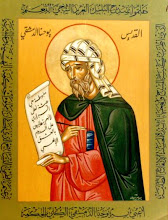This rambling introduction to Orthros does not pretend to be authoritative or ground-breaking. Much historic detail is simply excluded. The purpose is to provide a bit of context for members of our community who are still becoming familiar with the Service.
As it is rather lengthy (nearly four thousand words), I will be posting it in sections. And needless to say, if anyone sees need for correction, please contact me!
An Introduction to Orthros in the Byzantine Tradition
It is understood that the Divine Liturgy is the summit and heart of Byzantine Worship. The community gathered at the Altar of our Lord’s sacrifice offering up their prayers and sharing in the thanksgiving offering of His Body and Blood expresses the essence of our Eastern Christian experience.
Yet the Divine Liturgy, essential and of paramount importance, is only part of the Byzantine worship tradition. Other services surround and enhance that Eucharistic banquet and deepen its meaning and reception among the people of God. These services sanctify the day, the week, the season and the year. Along with the Divine Liturgy, they give substance and meaning to the Christian life.
The offices of Orthros and Vespers (morning and evening prayer) are, next to the Liturgy, the most vital services of the Byzantine Tradition. These services have developed over the millennia to celebrate both the particular day and the cycle of seasons in the Church Year. In this way, they relate the celebration of the Liturgy to the life of the Church and the life the individual Christian.
Let us look at Sunday Orthros.
Orthros – The Term and Origin of the Service
“Orthros” comes from the Greek word meaning “arise”, and is the proper service for the morning. In fact, it is properly celebrated beginning in the early hours before dawn, with sunrise anticipated to occur around halfway through the service. Orthros is properly a combination of two older services roughly corresponding to the Roman Rite Matins and Lauds in the West. Combining elements from these two older liturgical services, the reading of psalms, standard and variable hymns of Orthros produce an almost symphony-like movement of adoration and praise of God and veneration to His saints.
Orthros, Vespers, and the other “Hours” offices have experienced significant evolution over the millennia. At one time, a “cathedral” office coexisted with a “monastic” office. Over the centuries, the “monastic” office became standard and incorporated elements of the “cathedral” office into its structure. Thus, today, there are different orders of Orthros for Sunday and Feasts, weekday commemorations of varying importance, and Great Lent. In this review, we will focus on Sunday/Feast day Orthros.
It should be noted at the outset that if one reviews the outline and rubrics of Orthros it is clear that the full celebration of the service would easily require a few hours. In parish usage, elements are abbreviated or eliminated to bring the time down to around an hour or so. As we proceed to examine Orthros we will indicate these abbreviations and ‘short-cuts’.
One might argue that as the service is so routinely shortened it would be appropriate simply to produce a standard ‘shortened” version of the service. However, preserving the complete text, and with it options for a more complete celebration, both allows for more variety of choice and encourages the faithful to a fuller celebration.
Subscribe to:
Post Comments (Atom)


No comments:
Post a Comment